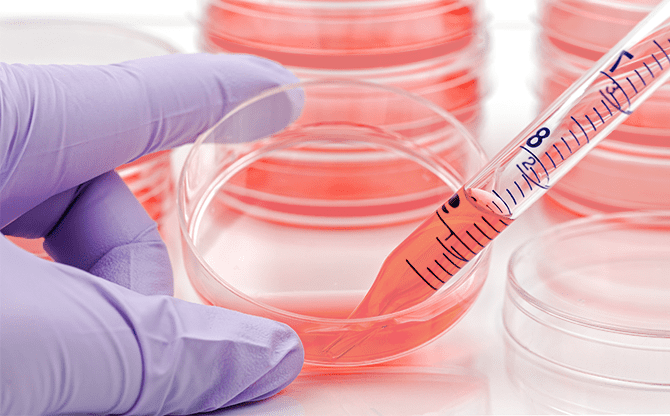The Role of Cell Culture in Regenerative Medicine
Regenerative medicine is increasingly in the spotlight as its clinical relevance grows around the world, rapidly creating an industry around itself. We will introduce the role of cell culture in regenerative medicine, including examples of how various types of stem cells are used in regenerative medicine and drug discovery screening, along with the history of their use.
Cell Culture that Helps Put Regenerative Medicine into Practical Use

Regenerative medicine uses cells as therapeutic agents for medical treatments aimed at rebuilding, repairing, and/or forming healthy body structure and function, as well as disease prevention. Regenerative medicine often relies on cells or tissues from the patients themselves or healthy donors. These cells are cultured or processed in some other manner after having been removed from the person.
Cell culture includes processes for isolating cells from tissue and maintaining, proliferating, and/or differentiating the cells in a culture vessel containing medium.
Cells are cultured in a manner such that their main characteristics are maintained, even after having been removed from their respective organ or tissue. For example, cells that were floating in the blood while in living tissue are cultured as suspended cells, while cells that were in contact with cells or extracellular matrices in organs or tissues are cultured as adherent cells.
Advances in cell culture technology, including culture media, culture vessels, and culture techniques, have enabled in vitro reproduction of in vivo characteristics and functions of cells, tissues, and organs. Cultured cells are not only used for basic research in biology and molecular biology, but also for drug discovery and regenerative medicine.
History of the Application of Stem Cells in Regenerative Medicine
It has long been known that the body has the ability to regenerate. However, human fingers do not regenerate like the tail of a newt does. Why is it that such regeneration does not happen in humans? Many studies have been done to try to solve this question.
In 1952, the use of epidermal cell suspensions as skin transplants was reported using rabbits1).This may be the first example of regenerative medicine research. The successful culture of keratinocytes, including stem cells and daughter cells in the basal layer of the skin, in the 1970's kick-started a new era of regenerative medicine. Since then, research on regenerative medicine has advanced significantly and regenerative medical products are used in many treatments. One example is a treatment where a portion of unscalded skin is collected from a patient with burns, the keratinocytes removed and allowed to proliferate and differentiate into new skin, and the new skin transplanted2).
Tissue stem cells
Cells that can differentiate only in a specific direction, with the self-renewal ability to divide and create the same cells as themselves in tissue, such as keratinocytes, are called tissue stem cells. Many of the regenerative medical products that are currently used for treatment are tissue stem cells that have been made to proliferate outside the body using cell culture techniques.
Mesenchymal stem cells (MSCs)
In 1970, cells with the ability to differentiate into various cells (multipotency) were discovered in the bone marrow of guinea pigs3). These cells are called mesenchymal stem cells (MSCs), and were later confirmed in 1999 to be present in human bone marrow as well4). It is now known that MSCs are not only present in bone marrow but also in various tissues, such as adipose tissue and the umbilical cord.
Many clinical trials are conducted using MSCs worldwide, and more products are being approved.
Embryonic stem cells (ESCs)
In 1981, mouse embryonic stem cells (ESCs) with the ability to self-renew and differentiate into cells that make up the body (pluripotency) were established5). In 1998, the world's first human ESCs were established6). Since then, research and development activities for differentiation into various cell types have accelerated. Clinical trials began in 2010 using human ESC-derived oligodendrocytes, the supporting cells that protect nerves from ESCs, for transplant into patients with spinal cord injury.
Induced pluripotent stem cells (iPSCs)
In 2007, induced pluripotent stem cells (iPSCs) with potency similar to ESCs were established from cells of differentiated tissues of the living human body7). Utilizing iPSC technology, the pluripotent stem cells required for certain regenerative medical products can be made from the cells of one's own body, eliminating the risk of immunorejection, which is a problem in transplantation. Furthermore, this invention enabled the creation of patient-derived cardiomyocytes and nerve cells in sufficient quantities for use in research, as well as the in vitro production of cell models for various diseases. In many countries, various disease model iPSCs are now being established and differentiated into disease model cells for use in research, candidate drug screening, and verification of drug side effects. Advancements in research and development has opened doors for pioneering new therapeutic agents.
Now, there are a variety of stem cell options, and our understanding of stem cell culture has matured greatly. These factors, together with the movement toward industry-government-academia collaboration, have accelerated industrialization of regenerative medicine, including efforts to improve quality and reduce cost. Cell culture technology, in particular, plays a critical role in the industrialization of regenerative medicine.
References
1) Br J Plast Surg. 1952; 5: 25-36.
2) Cell. 1975; 6: 331-43
3) Cell Tissue Kinet. 1970; 3(4): 393-403.
4) Science. 1999; 284(5411): 143-7
5) Nature. 1981; 292: 154–6.
6) Science. 1998; 282(5391): 1145-7.

